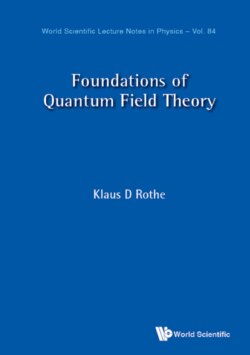Читать книгу Foundations of Quantum Field Theory - Klaus D Rothe - Страница 32
На сайте Литреса книга снята с продажи.
Dirac spinors in the Weyl representation
ОглавлениеWe now present a derivation of the Dirac equation based on group-theoretical arguments alone. Our fundamental requirement will be that the solution of the “relativistic Schrödinger equation” should belong to a representation of the Lorentz group. In particular consider the irreducible representations (1/2,0) and (0,1/2) in (2.28). Denoting the wave functions in the respective representations by φ(x) and , this means that in analogy to (2.4), under Lorentz transformations,
The operators acting on these fields are thus given by 2 × 2 matrices. A complete set of such matrices is given by the identity and the three Pauli matrices. As we next show the set of four matrices5
transform as a “4-vector” in the following sense:
Note that these transformation laws cannot be interpreted as a change in basis. They are easily verified for an infinitesimal Lorentz transformation
and the corresponding expression for the (1/2,0) and (0,1/2) representations (2.29) and (2.30) with
We have
Notice that the rotational part does not care about which of the two representations we are in. Keeping only terms linear in the parameters we have
(i)for t0 = 1,
(ii)for ti = σi,
On the other hand we have for an infinitesimal Lorentz transformation ,
In accordance with our previous parametrization we have
where we have set t0 = 1. This establishes our claim (4.25) for tμ. In a similar way one demonstrates the transformation law (4.26). It now follows from (4.25) and (4.26) that the equations
transform covariantly under Lorentz transformations.6 Indeed, multiplying the first equation from the left with and making the replacement x → x′ = Λx, one has
or recalling that , we have from (4.25)
Together with (4.22) this implies
which proves the covariance of Eq. (4.27). In the same way, one also proves the covariance of the second equation.
Equations (4.27), (4.28) represent a coupled set of equations, which only decouple in the case of zero-mass fermions. They may be collected into a single equation by defining the 4 × 4 matrices
where the subscript W stands for “Weyl”.7 One explicitly checks that they satisfy the anticommutation relations
Writing ψ(x) in the form
the above coupled set of equations takes the form
Multiplying this equation from the left with the operator (iγμ∂μ + m) and using the anticommutation relations (4.30) we see that ψ is also a solution of the Klein–Gordon equation:
describing the propagation of a free particle with the correct energy-momentum relation. By further defining the 4 × 4 matrices (in the Weyl-representation)
the transformation laws (4.25), (4.26) can be collected to read
and
On this level we now have manifest Lorentz covariance of the Dirac equation (4.8). Note also that the inverse of the matrix is now equivalent to the corresponding “Dirac” adjoint (recall (2.33))
This will play an important role when we come to define scalar products.
We now decompose the solution to the Dirac equation as in (4.9). For and the Dirac equation then reads
Recalling the explicit form of the (1/2,0) and (0,1/2) representations (2.36) of boosts, we conclude that
Recalling from (2.32) that , we can solve the set of algebraic equations (4.36) for the four independent Dirac spinors, to give
where and have been normalized with respect to the scalar product (4.19).
Making use of the explicit form (2.37) and (2.38) of the 2 × 2 matrices representing the boosts, one can rewrite the expressions (4.38) in the explicit form
Comparing with (4.21), we seem to be arriving at different results. In fact, these results can be shown to be unitarily equivalent. Indeed, the γμ-matrices (4.29) and (4.7) are related by the unitary transformation
with
Correspondingly we have for the Dirac spinors
which are readily seen to coincide with the spinors (4.21).
The basis in which the γ-matrices take the form (4.7) is referred to as the Dirac representation. The basis in which the γ-matrices take the form (4.29) is referred to as the Weyl representation. The same applies to the Dirac spinors (4.21) and (4.39), respectively.
The choice of representation is a matter of taste and depends on the specific problem and question one wants to address. Thus, to discuss the non-relativistic limit of the Dirac equation, it is convenient to work in the Dirac representation. If one is dealing with massless charged fermions, it is more convenient to work in the Weyl representation, since the Dirac equation reduces to two uncoupled equations in this case. We shall have the opportunity to work in still another basis, the so-called Majorana representation, which turns out to be particularly suited if the fermions are massless and charge neutral (neutrinos, for example).
